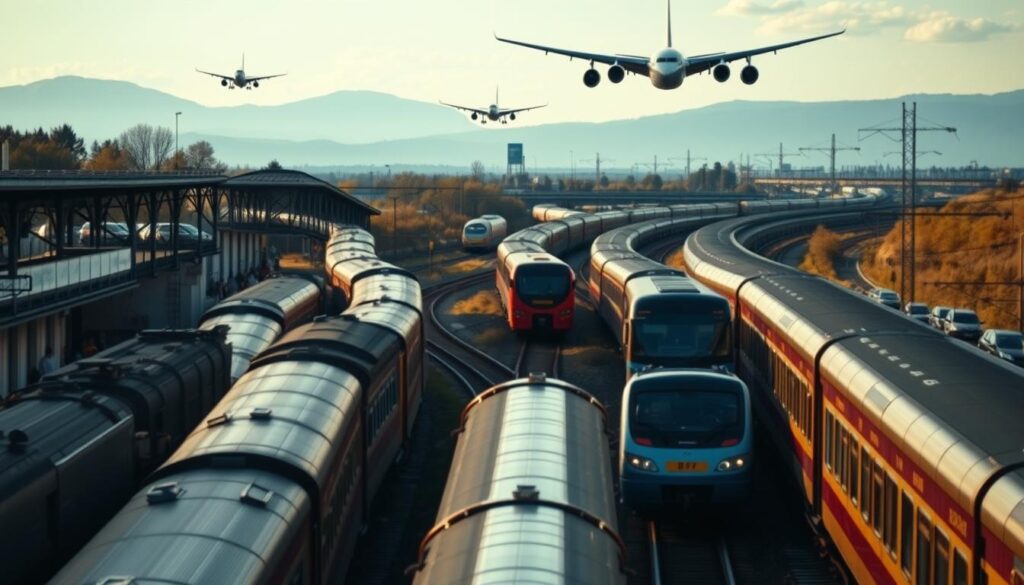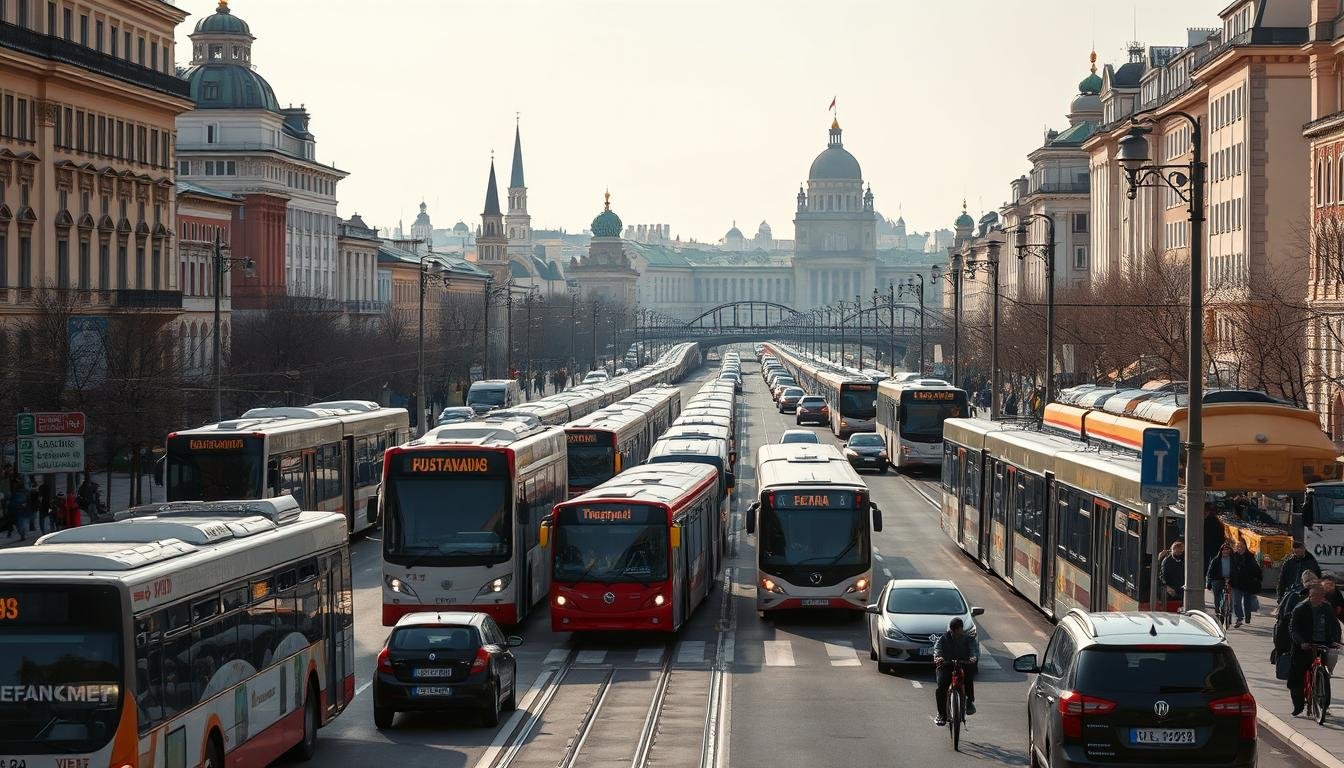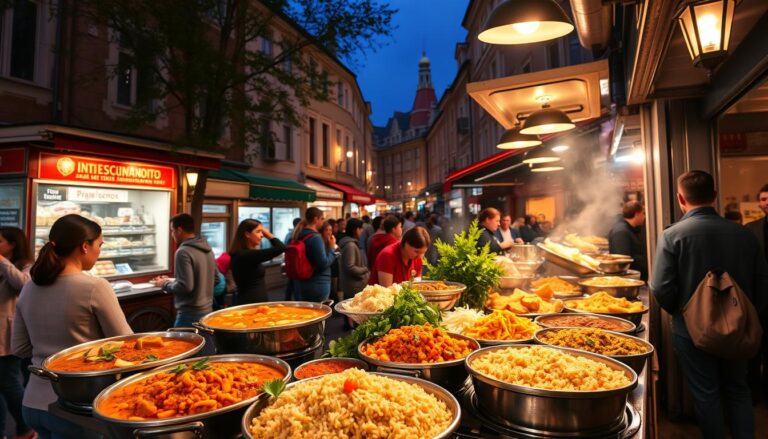Moving to a new city can be exciting, but figuring out how to get around can feel overwhelming. Whether you’re exploring bustling streets or commuting to your university, understanding the local transport system is key to settling in smoothly.
We’ve created a detailed resource to help you master the art of city travel. From cost-effective options to essential tips, our guide ensures you’ll feel confident navigating public transit. Familiarizing yourself with these methods not only saves time but also helps you feel more at home in your new environment.
Our approach is based on reliable data and personal experience, making it easier for you to adapt. Whether you’re planning your daily commute or exploring new areas, we’re here to walk you through every step. For more insights, check out Perm State Medical University, a great example of how students thrive in a new setting.
Understanding the Russian Transportation Network
Russia’s transportation network is a blend of history and innovation, shaping how people move across the country. From its vast railway system to modern metro networks, this infrastructure connects urban hubs and remote regions seamlessly.
Historical Background and Evolution
The roots of Russia’s railway system date back to the 19th century under Nicholas I. It began as a pioneering effort to link major cities and support economic growth. Over time, the network expanded, becoming one of the largest in the world.
Key stations like Moscow’s Kazansky and St. Petersburg’s Moskovsky played central roles in this evolution. These hubs not only facilitated travel but also became symbols of the country’s progress. Today, the network spans over 85,000 kilometers, making it a cornerstone of Russia’s infrastructure.
Modern Advancements and Integration
Modern technology has transformed Russia’s transport system. Digital ticketing, for example, has streamlined the process of booking and boarding. Apps and smart cards allow travelers to plan routes and pay with ease.
Russian Railways (RZD) ensures the system’s reliability, with 98% of trains arriving on time. High-speed routes like the Sapsan connect cities like Moscow and St. Petersburg in just four hours. This efficiency makes it a preferred choice for both locals and visitors.
For those exploring other regions, the network offers a mix of affordability and convenience. Whether you’re traveling across the country or within a city, the system is designed to meet diverse needs. For more insights into efficient transit options, check out Samarkand’s public transport system, which shares similar principles of accessibility and innovation.
Public Transport Insights: Metro, Bus, and Train Options
Navigating a new city’s public transit can be both an adventure and a challenge. From metros to trams, these systems are designed to make daily commutes seamless and efficient. Understanding how they work can transform your travel experience and help you explore with confidence.
Exploring the Metro Marvels
The metro systems in cities like Moscow and St. Petersburg are not just efficient but also cultural landmarks. With over 260 km of tracks and 160 stations, the Moscow metro serves millions daily. Stations like Mayakovskaya and Komsomolskaya are known for their stunning architecture.
Trains run every 2-3 minutes, ensuring minimal wait times. Digital ticketing and real-time updates make the metro a reliable choice for commuters. Whether you’re heading to work or exploring the city, the metro is a fast and affordable option.
Efficient Bus and Tram Services
Buses and trams play a vital role in connecting neighborhoods and suburbs. In Moscow, bus stops are marked with the letter “A,” while tram stops use “T.” These services are frequent, with routes designed to cover key areas.
Modern technology has enhanced these services. Apps provide real-time updates, and smart cards simplify payments. Whether you’re traveling short distances or across the city, buses and trams offer a convenient and cost-effective ride.
Scenic Train Journeys
Train travel in Russia is more than just a way to get around—it’s an experience. High-speed trains like the Sapsan connect major cities in just a few hours. These journeys offer breathtaking views of Russia’s vast landscapes.
For longer trips, sleeper trains provide comfort and affordability. With routes spanning over 85,000 km, the train network is a cornerstone of Russia’s transport system. Whether you’re commuting or exploring, trains are a reliable and scenic option.
| Mode | Frequency | Cost (RUB) | Key Features |
|---|---|---|---|
| Metro | Every 2-3 minutes | 60 | Fast, affordable, cultural stations |
| Bus | Every 10-15 minutes | 12 | Extensive routes, real-time updates |
| Tram | Every 10-20 minutes | 10 | Eco-friendly, connects neighborhoods |
| Train | Hourly (long-distance) | Varies | Scenic, sleeper options, high-speed |
Transportation Guide Students Russia
Mastering the art of commuting in a new city starts with knowing the best routes and tools. Whether you’re heading to class or exploring the city, understanding the most efficient paths can save time and reduce stress. We’ve outlined key routes and apps to make your journey seamless.
Essential Routes for University Campuses
University campuses are often well-connected to major city centers. In Moscow, for example, the metro system links key areas like Red Square to campuses such as Lomonosov Moscow State University. Buses and trams also provide reliable options for shorter distances.
Here’s a quick overview of essential routes:
| City | Route | Mode | Travel Time |
|---|---|---|---|
| Moscow | Red Square to Lomonosov University | Metro | 20 minutes |
| St. Petersburg | Nevsky Prospekt to St. Petersburg State University | Tram | 15 minutes |
| Kazan | Kremlin to Kazan Federal University | Bus | 10 minutes |
Utilizing Technology and Apps
Technology has revolutionized how we plan our journeys. Apps like Yandex and Citymapper provide real-time updates, helping you choose the best route at any given time. These tools also offer features like fare estimates and step-by-step navigation.
Here’s how to make the most of these apps:
- Download apps like Yandex or Citymapper for real-time updates.
- Use smart cards for contactless payments on buses and metros.
- Check multiple options to find the fastest or most affordable ride.
By combining traditional knowledge with modern tools, you can navigate the city with confidence. Whether you’re commuting daily or exploring new areas, these resources ensure a smooth journey.
Tips for Buying Tickets and Using Transport Apps
Understanding how to purchase tickets and use transport apps can make your daily commute hassle-free. Whether you’re traveling by metro, bus, or train, knowing your options ensures a smooth journey. We’ll walk you through the best practices for ticketing and app usage to save time and money.
E-Ticketing and Mobile Registrations
E-ticketing has revolutionized how we travel. Instead of standing in long lines, you can now purchase tickets online or through mobile apps. Platforms like Yandex and official transport services offer easy registration and secure payment options.
Here’s how to get started:
- Download the app and create an account using your email or phone number.
- Link your payment method for seamless transactions.
- Select your route and purchase your ticket in just a few taps.
E-tickets are not only convenient but also eco-friendly. They eliminate the need for paper tickets and can be stored directly on your phone.
Smart Cards and Contactless Payments
Smart cards like Moscow’s Troika card are a game-changer for frequent travelers. These cards allow you to load funds and use them across multiple transport services. Simply tap your card at the station or on the bus, and you’re good to go.
Benefits of smart cards include:
- Discounted fares for regular commuters.
- Integration with apps for real-time balance checks.
- Contactless payments for faster boarding.
For those exploring other cities, apps like Tashkent’s public transport system offer similar features, making travel seamless even abroad.
By combining e-ticketing and smart cards, you can enjoy a stress-free travel experience. Always compare prices and verify details at the station to ensure you’re getting the best deal. With these tools, your daily commute becomes efficient and enjoyable.
Long-Distance Travel: Trains, Flights, and Coaches
Long-distance travel in Russia offers a mix of comfort, efficiency, and affordability. Whether you’re planning a trip across the country or exploring neighboring regions, understanding your options ensures a smooth journey. From high-speed trains to budget-friendly coaches, we’ll guide you through the best ways to travel long distances.
Booking in Advance for Best Fares
Securing the best fares starts with early planning. For train travel, booking opens 90 to 120 days ahead, allowing you to lock in lower prices. High-speed options like the Sapsan train are popular for routes such as Moscow to St. Petersburg, with tickets starting at 1,400 roubles for economy class.
Flights are another efficient option, especially for longer distances. Domodedovo International Airport, Russia’s busiest, connects major cities with daily flights. Booking in advance can save you up to 50% on airfare, making it a cost-effective choice for students and travelers alike.
Sleepers and Multi-Modal Journeys
Sleeper trains are a unique way to cover vast distances comfortably. The Krasnaya Strela (Red Arrow) offers overnight journeys from Moscow to St. Petersburg, with tickets priced around 6,000 roubles for top-quality service. For budget travelers, Platskartny (3rd class) provides an affordable yet cozy option.
Multi-modal travel combines different transport modes for flexibility. For example, you can take a train to a major hub and then switch to a coach for remote areas. This approach not only saves money but also allows you to explore regions beyond the main routes.

Here’s a comparison of long-distance travel options to help you choose the best route:
| Mode | Route | Fare (RUB) | Travel Time |
|---|---|---|---|
| Train (Sapsan) | Moscow to St. Petersburg | 1,400 | 3h 50m |
| Flight | Moscow to Kazan | 2,500 | 1h 30m |
| Coach | Moscow to Nizhny Novgorod | 800 | 4h |
| Sleeper Train | Moscow to Vladivostok | 15,000 | 7 days |
For students, early booking and fare comparisons are key to reducing costs. Sleeper trains and multi-modal journeys not only save money but also add comfort to your trip. By understanding schedules and routes, you can optimize your long-distance travel experience.
Exploring Urban Transit: Metro Systems in Moscow & St. Petersburg
Exploring the metro systems in Moscow and St. Petersburg reveals a blend of art and efficiency. These networks are not just about getting from one place to another; they are cultural experiences in themselves. From stunning architecture to precise timetables, these systems are designed to make commuting seamless and enjoyable.
Architectural Wonders and Cultural Significance
The metro stations in Moscow and St. Petersburg are architectural marvels. Stations like Mayakovskaya and Komsomolskaya showcase intricate mosaics and grand designs. These spaces are more than transit hubs; they are galleries of Russian history and culture.
In St. Petersburg, the metro stations reflect the city’s imperial past. With their elegant chandeliers and marble walls, they offer a glimpse into the country’s rich heritage. Each station tells a story, making every journey a unique experience.
Timetables and Peak Hour Strategies
Navigating the metro during peak hours requires planning. Trains in Moscow run every 2-3 minutes, ensuring minimal wait times. However, stations can get crowded between 7 AM and 10 AM, as well as from 4 PM to 7 PM.
Here are some tips to avoid the rush:
- Use apps like Yandex for real-time updates on train schedules.
- Plan your route to avoid the busiest stations during peak hours.
- Consider traveling slightly earlier or later to save time and stress.
In cities like Nizhny Novgorod, similar strategies apply. Understanding the timetable and choosing the right route can make a significant difference in your daily commute.
By combining these tips with modern technology, you can navigate the metro systems with ease. Whether you’re heading to work or exploring the city, these networks are designed to meet your needs efficiently.
Local and Regional Commute: Buses, Trams, and Taxis
Local commuting options in Russian cities offer a mix of convenience and efficiency for daily travel. Whether you’re heading to class or exploring the city, understanding these systems ensures a smooth journey. Buses, trams, and taxis are integral to navigating urban and regional routes, each offering unique advantages.
Reliable Taxi and Ride-Sharing Options
Taxis and ride-sharing apps are popular for their flexibility and speed. Services like Yandex.Taxi provide reliable options with real-time tracking and fare estimates. These apps ensure safety by verifying drivers and offering transparent pricing.
Here’s how to make the most of these services:
- Download verified apps like Yandex.Taxi for secure rides.
- Check reviews and ratings before booking a trip.
- Use ride-sharing during peak hours to save time and money.
For those considering long-term stays, car-sharing services are also available. These options are ideal for exploring regions beyond the city center.
Tram and Trolleybus Experiences
Trams and trolleybuses are eco-friendly and cost-effective for daily commutes. In cities like Moscow, these systems cover extensive routes, connecting neighborhoods and suburbs. Trams are particularly useful for short trips, with frequent stops and affordable fares.
Here are some tips for using trams and trolleybuses:
- Check station timetables for real-time updates.
- Use smart cards for contactless payments.
- Plan your route to avoid crowded times during the day.
By combining these options, you can navigate the city with ease. Whether you’re commuting daily or exploring new areas, these systems are designed to meet your needs efficiently. For more insights into affordable living while studying MBBS in Russia, check out our detailed guide.
Student Travel Cards and Discount Options
Student travel cards are a game-changer for daily commuting. These cards not only simplify your journey but also offer significant savings. Whether you’re traveling by metro, bus, or tram, having the right card can make all the difference.
How to Apply and Activate Your Card
Applying for a student travel card is straightforward. Start by gathering the required documents, such as your passport and student ID. Most cities, like Moscow, offer online applications through their official transport websites or apps.
Here’s a step-by-step guide:
- Visit the official transport website or download the app.
- Fill out the application form with your personal and academic details.
- Upload scanned copies of your passport and student ID.
- Submit the form and wait for confirmation via email or SMS.
Once approved, activate your card by linking it to your account. This allows you to recharge and manage your balance seamlessly.
Benefits and Savings for Daily Commuting
Student travel cards offer numerous benefits. In Moscow, the Troika card provides discounted fares for metros, buses, and trams. These savings add up, especially for daily commuters.
Here’s how you can maximize your card’s benefits:
- Use the card across multiple transport systems for convenience.
- Recharge your balance through the app to avoid last-minute hassles.
- Check for additional discounts during off-peak hours or special promotions.
For example, Youth Pass discounts can reduce standard fares by up to 25%. This makes exploring the city more affordable and enjoyable.
By integrating your card with transport apps, you can plan your route, check real-time updates, and monitor your spending. This ensures a smooth and efficient commuting experience.
Safety, Accessibility, and Practical Tips
Traveling in a new environment can be both exciting and challenging, especially when safety and accessibility are top priorities. Whether you’re navigating public transit or exploring unfamiliar areas, being prepared ensures a smooth journey. Here are some essential tips to help you stay safe and confident during your travels.
Overcoming Language Barriers and Navigation Issues
Language barriers can make travel more difficult, but there are ways to overcome them. Translation apps like Google Translate can help you communicate and understand signs. Look for clearly marked signage in metro stations and bus stops, as they often include symbols and numbers for easy navigation.
Here are some tips to make navigation easier:
- Download offline maps to avoid relying on internet access.
- Use apps with real-time updates to plan your route minute by minute.
- Keep a backup ticket or digital copy in case of unexpected issues.
Security and Personal Safety Measures
Personal safety is crucial, especially in crowded or unfamiliar environments. Always keep track of your belongings, especially in busy areas like train stations or buses. Be aware of your surroundings and avoid displaying valuables openly.
Here are some security measures to follow:
- Verify taxi fares and driver identity before starting your ride.
- Use registered taxi services or apps for added safety.
- Keep emergency contacts saved on your phone for quick access.
Must-Have Essentials for a Smooth Journey
Being prepared with the right essentials can prevent unexpected cases of delays or mishaps. Always carry a small travel kit with backup tickets, essential documents, and a portable charger. This ensures you’re ready for any situation.
Here’s a checklist of must-have items:
| Item | Purpose |
|---|---|
| Backup Tickets | In case of loss or technical issues |
| Portable Charger | Keep your phone powered for updates |
| Emergency Contacts | Quick access to help if needed |
| Translation App | Overcome language barriers |
By following these tips and staying prepared, you can ensure a safe and enjoyable travel experience. Always have a few extra ride options in case of delays, and use available tools to verify schedules and routes. With the right approach, you’ll navigate your journey with confidence.
Conclusion
Exploring the diverse transit systems in major cities like St. Petersburg and Moscow reveals a world of efficiency and cultural richness. From metros to buses, each mode of transport offers unique benefits for daily commuting. By leveraging official websites and apps, you can stay updated on schedules and fares, ensuring a smooth journey.
Reliable service and robust networks make navigating these cities seamless. Whether you’re traveling by train or car, understanding the local system enhances your experience. Planning ahead and using digital tools empowers you to travel confidently, even in a foreign country.
We hope this guide has provided valuable insights into making the most of your daily commute. For more information on affordable education options, check out our study MBBS abroad guide. Embrace the journey and enjoy the vibrant culture of these remarkable cities.





